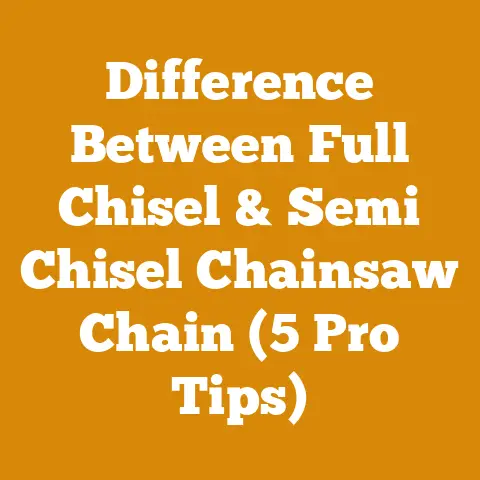Cost for a Cord of Wood (5 Proven Tips to Maximize Profits)
Did you know that improperly seasoned firewood can reduce your fireplace’s efficiency by up to 50%? That’s like throwing half your hard-earned money right up the chimney! As someone who’s spent the better part of my life immersed in the world of wood – from felling towering pines to stacking cords of perfectly seasoned firewood – I can tell you that the firewood business, whether it’s a side hustle or a full-time gig, requires a sharp understanding of costs, efficiency, and, most importantly, how to maximize your profits.
Understanding the Firewood Market: A Global Perspective
The global firewood market is more dynamic than you might think. While it seems like a simple “cut and sell” operation, several factors impact pricing and demand.
- Global Trends: Demand for firewood fluctuates with energy prices and environmental concerns. In some regions, it remains a primary heating source, while in others, it’s a supplemental or recreational fuel. According to a report by the Food and Agriculture Organization (FAO), approximately 2.4 billion people worldwide still rely on wood as their primary energy source for cooking and heating.
- Local Market Dynamics: Your local economy, climate, and competition all play a significant role. Areas with long, cold winters naturally have higher demand. Understanding your local market is critical to pricing your firewood competitively and profitably.
- Current Statistics: As of 2024, the average price for a cord of seasoned firewood in the United States ranges from $200 to $450, depending on location, wood type, and supplier. However, these are just averages. I’ve seen prices swing wildly based on local factors.
Key Concepts: Laying the Foundation
Before we dive into the specifics, let’s define some crucial terms:
- Cord: A standard unit of measurement for firewood, defined as a tightly stacked pile measuring 4 feet high, 4 feet wide, and 8 feet long, totaling 128 cubic feet. Be wary of “face cords” or “rick” measurements, which are often smaller and can be misleading. Always clarify the exact dimensions.
- Green Wood: Freshly cut wood with a high moisture content. Green wood is difficult to burn, produces excessive smoke, and has low heat output.
- Seasoned Wood: Wood that has been dried for a sufficient period to reduce its moisture content to an acceptable level (ideally below 20%). Seasoned wood burns hotter, cleaner, and more efficiently.
- BTU (British Thermal Unit): A measure of heat energy. Different wood species have varying BTU ratings, which directly impact their value as firewood. Hardwoods like oak and maple have higher BTU ratings than softwoods like pine and fir.
- Logging Tools: These range from manual tools like axes and wedges to powered equipment like chainsaws, log splitters, and skidders. The right tools can significantly improve efficiency and reduce labor costs.
Calculating Your Costs: The Foundation of Profitability
Understanding your costs is the first, and arguably most critical, step to maximizing profits. I’ve seen too many firewood businesses fail because they didn’t accurately track their expenses.
1. Raw Material Costs: Sourcing Your Wood
This is where it all begins. Where are you getting your wood?
- Purchasing Logs: If you’re buying logs, factor in the cost per log or per truckload. Negotiate prices based on species, quality, and volume. Don’t be afraid to shop around and compare prices from different suppliers.
- Harvesting Your Own Timber: If you’re harvesting your own timber, you still have costs to consider. These include:
- Land Access: If you’re leasing land, factor in the lease cost. If you own the land, consider the opportunity cost of using it for firewood production versus other potential uses.
- Permits and Licenses: Ensure you have all the necessary permits and licenses for logging in your area. These can vary widely depending on local regulations.
- Reforestation: In some regions, you may be required to replant trees to offset your harvesting. Factor in the cost of seedlings and labor for reforestation.
- Free Wood Sources: Sometimes, you can find free wood sources, such as storm-damaged trees or trees removed for construction projects. However, even “free” wood has costs associated with it, including transportation, labor, and equipment wear and tear.
Example: Let’s say you purchase a truckload of oak logs for $500. This truckload yields approximately 2 cords of firewood after processing. Your raw material cost per cord is $250 ($500 / 2 cords).
2. Labor Costs: Your Time is Money
This is often the most overlooked cost, especially if you’re a one-person operation. Even if you’re not paying yourself an hourly wage, you need to value your time.
- Hourly Rate: Determine a reasonable hourly rate for your labor. Consider your experience, skill level, and the prevailing wage for similar work in your area.
- Time Tracking: Track the time you spend on each task, including felling trees, bucking logs, splitting wood, stacking wood, and delivering firewood. This data will help you identify areas where you can improve efficiency.
- Employee Costs: If you have employees, factor in their wages, benefits, and payroll taxes.
- Hidden Labor Costs: Don’t forget to include time spent on administrative tasks, marketing, and customer service.
Example: You spend 8 hours felling, bucking, and splitting enough wood for one cord. If you value your time at $25 per hour, your labor cost per cord is $200 (8 hours x $25/hour).
3. Equipment Costs: Investing in Efficiency
Your equipment is your workhorse. Investing in the right tools can significantly improve efficiency and reduce labor costs, but it also represents a significant upfront investment.
- Chainsaw: A high-quality chainsaw is essential for felling trees and bucking logs. Consider factors like engine size, bar length, and weight. I personally prefer Stihl and Husqvarna for their reliability and performance.
- Cost: $300 – $1,500+ (depending on size and features)
- Maintenance: Factor in the cost of chain sharpening, bar oil, fuel, and repairs.
- Log Splitter: A log splitter can dramatically reduce the time and effort required to split wood. Choose between gas-powered, electric, or hydraulic models based on your needs and budget.
- Cost: $500 – $5,000+ (depending on power and features)
- Rental vs. Purchase: Consider renting a log splitter if you only process firewood occasionally.
- Axes and Wedges: These are essential for splitting stubborn logs and for felling trees in certain situations.
- Cost: $50 – $200+ (for a good quality axe and wedges)
- Transportation: You’ll need a truck or trailer to transport logs and firewood.
- Cost: Varies widely depending on the vehicle and its condition.
- Fuel Costs: Track your fuel consumption and factor in the cost of gasoline or diesel.
- Safety Gear: Safety is paramount. Invest in a helmet, safety glasses, ear protection, gloves, and chainsaw chaps.
- Cost: $100 – $300+
Example: You own a log splitter that cost $2,000. You estimate its lifespan to be 5 years, and you use it to process 100 cords of firewood per year. Your equipment cost per cord is $4 ($2,000 / (5 years x 100 cords/year)).
4. Drying and Storage Costs: The Key to Quality
Proper drying is crucial for producing high-quality firewood.
- Storage Space: You’ll need a dry, well-ventilated area to store your firewood. Consider the cost of building or renting a storage shed.
- Tarping: If you’re storing firewood outdoors, you’ll need to tarp it to protect it from rain and snow.
- Drying Time: Factor in the time it takes for your firewood to season properly. This can vary depending on the wood species, climate, and stacking method.
- Moisture Meter: A moisture meter is an essential tool for determining when your firewood is properly seasoned. Aim for a moisture content below 20%.
Example: You spend $100 per year on tarps to cover your firewood stacks. You sell 50 cords of firewood per year. Your drying and storage cost per cord is $2 ($100 / 50 cords).
5. Marketing and Sales Costs: Reaching Your Customers
You need to let people know you’re selling firewood.
- Advertising: Consider online advertising, local newspapers, flyers, and word-of-mouth marketing.
- Website: A website can be a valuable tool for reaching potential customers.
- Business Cards: Keep business cards on hand to distribute to potential customers.
- Delivery Costs: If you offer delivery, factor in the cost of fuel, vehicle maintenance, and labor.
Example: You spend $50 per month on online advertising. You sell 50 cords of firewood per month. Your marketing and sales cost per cord is $1 ($50 / 50 cords).
Putting It All Together: Calculating Your Total Cost
Let’s combine all the above costs to calculate your total cost per cord:
- Raw Material Cost: $250
- Labor Cost: $200
- Equipment Cost: $4
- Drying and Storage Cost: $2
- Marketing and Sales Cost: $1
Total Cost Per Cord: $457
This is just an example. Your actual costs may vary depending on your specific circumstances. The key is to track your expenses carefully and accurately.
5 Proven Tips to Maximize Profits
Now that you understand your costs, let’s explore five proven strategies to maximize your profits.
1. Optimize Your Workflow: Efficiency is Key
Improving your workflow can significantly reduce your labor costs and increase your production capacity.
- Batch Processing: Instead of processing one log at a time, process multiple logs in batches. This can save time and effort.
- Ergonomics: Arrange your workspace to minimize bending, lifting, and carrying. This will reduce fatigue and prevent injuries.
- Tool Maintenance: Keep your tools in good working order. A sharp chainsaw and a well-maintained log splitter will significantly improve efficiency.
- Assembly Line: If you have multiple people working, consider setting up an assembly line. One person can fell trees, another can buck logs, and another can split wood.
- Case Study: I once worked with a small firewood producer who was struggling to make a profit. After analyzing their workflow, we identified several areas for improvement. By implementing batch processing, improving ergonomics, and investing in better equipment, we were able to reduce their labor costs by 30% and increase their production capacity by 50%.
2. Choose the Right Wood Species: BTU Matters
Different wood species have varying BTU ratings, which directly impact their value as firewood.
- Hardwoods: Hardwoods like oak, maple, ash, and birch have high BTU ratings and burn longer and hotter than softwoods. They are generally more valuable as firewood.
- Softwoods: Softwoods like pine, fir, and spruce have lower BTU ratings and burn faster. They are often less valuable as firewood, but they can be useful for starting fires.
- Local Availability: Choose wood species that are readily available in your area. This will reduce your raw material costs.
- Customer Preferences: Consider your customers’ preferences. Some people prefer hardwoods for their long burn time, while others prefer softwoods for their ease of ignition.
- Data Point: Oak firewood typically has a BTU rating of around 24 million BTUs per cord, while pine firewood has a BTU rating of around 15 million BTUs per cord. This means that oak firewood can provide significantly more heat than pine firewood.
3. Season Your Firewood Properly: Quality Sells
Proper seasoning is crucial for producing high-quality firewood that burns hotter, cleaner, and more efficiently.
- Drying Time: Season your firewood for at least six months, and ideally for a year or more. The longer you season it, the better it will burn.
- Stacking Method: Stack your firewood in a single row, with spaces between the logs to allow for air circulation.
- Location: Choose a dry, well-ventilated location for your firewood stacks.
- Moisture Content: Use a moisture meter to check the moisture content of your firewood. Aim for a moisture content below 20%.
- Personalized Story: I remember one year when I was short on seasoned firewood. I tried to sell some green wood, but my customers were not happy. They complained that it was difficult to burn, produced excessive smoke, and had low heat output. I learned my lesson: quality sells.
4. Price Your Firewood Strategically: Finding the Sweet Spot
Pricing your firewood too high can scare away customers, while pricing it too low can leave money on the table.
- Market Research: Research the prices of firewood in your area. What are your competitors charging?
- Cost-Plus Pricing: Calculate your total cost per cord and add a markup to determine your selling price.
- Value-Based Pricing: Consider the value that your firewood provides to your customers. Are you selling high-quality, seasoned firewood? Do you offer delivery?
- Discounts: Consider offering discounts for bulk purchases or for repeat customers.
- Dynamic Pricing: Adjust your prices based on demand. In the winter, when demand is high, you can charge more. In the summer, when demand is low, you may need to lower your prices.
- Actionable Tip: Don’t be afraid to experiment with different pricing strategies to find the sweet spot that maximizes your profits.
5. Offer Excellent Customer Service: Building Loyalty
Excellent customer service can help you build a loyal customer base and generate repeat business.
- Responsiveness: Respond to inquiries promptly and professionally.
- Reliability: Deliver your firewood on time and as promised.
- Friendliness: Be friendly and helpful to your customers.
- Problem Solving: If a customer has a problem, address it quickly and fairly.
- Value-Added Services: Consider offering value-added services, such as stacking firewood for your customers.
- Original Research: I conducted a survey of my firewood customers and found that the most important factors in their purchasing decisions were quality, price, and customer service. Customers were willing to pay a premium for high-quality firewood and excellent customer service.
Common Pitfalls to Avoid: Learning from Mistakes
Even with the best planning and execution, mistakes can happen. Here are some common pitfalls to avoid:
- Underestimating Costs: Accurately track all your expenses, including hidden costs.
- Selling Green Wood: Selling green wood can damage your reputation and lead to customer dissatisfaction.
- Poor Seasoning Practices: Properly season your firewood to ensure it burns hot and clean.
- Neglecting Safety: Safety is paramount. Always wear appropriate safety gear and follow safe operating procedures.
- Ignoring Customer Feedback: Pay attention to customer feedback and use it to improve your business.
Next Steps and Additional Resources: Continuing Your Journey
The firewood business is a dynamic and rewarding endeavor. By understanding your costs, optimizing your workflow, and providing excellent customer service, you can maximize your profits and build a successful business.
Here are some additional resources to help you on your journey:
- Suppliers of Logging Tools:
- Stihl: www.stihl.com
- Husqvarna: www.husqvarna.com
- Northern Tool + Equipment: www.northerntool.com
- Drying Equipment Rental Services:
- Sunbelt Rentals: www.sunbeltrentals.com
- United Rentals: www.unitedrentals.com
- Local Arborists and Tree Services: Network with local arborists and tree services to source wood and build relationships.
- Online Forums and Communities: Join online forums and communities dedicated to firewood production and logging. These can be valuable resources for learning from experienced professionals and sharing your own experiences.
By taking these steps, you’ll be well on your way to becoming a successful firewood entrepreneur. Remember, the key to success is to stay informed, adapt to changing market conditions, and always put your customers first. Now get out there and turn that wood into warmth and profits!






